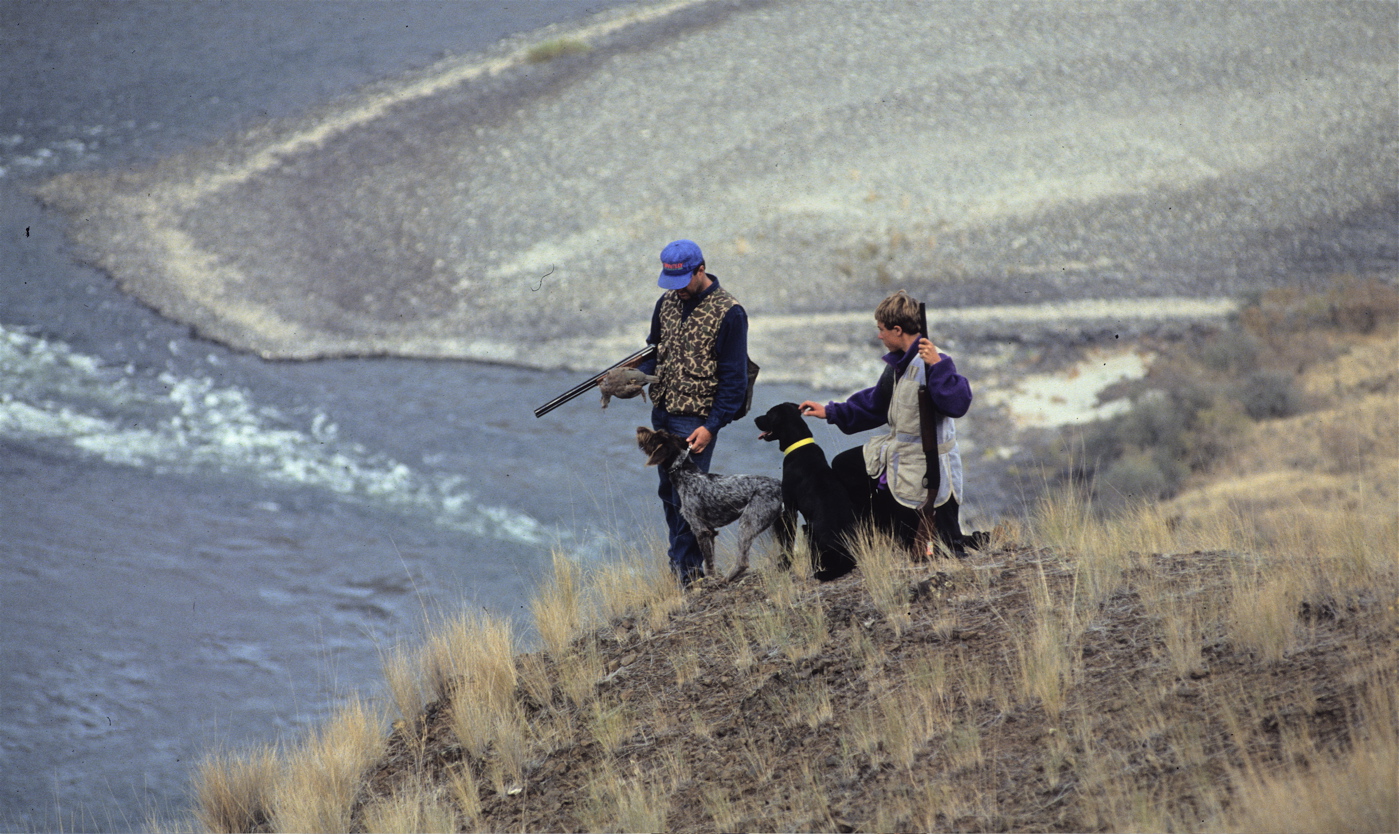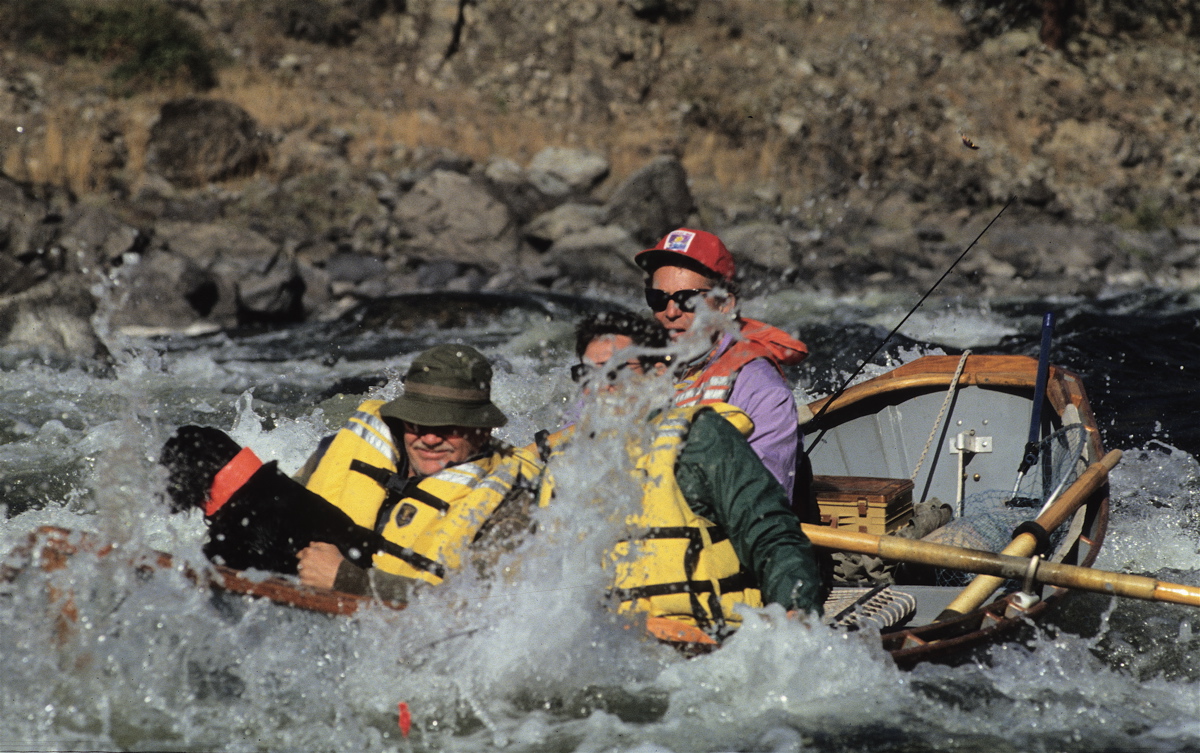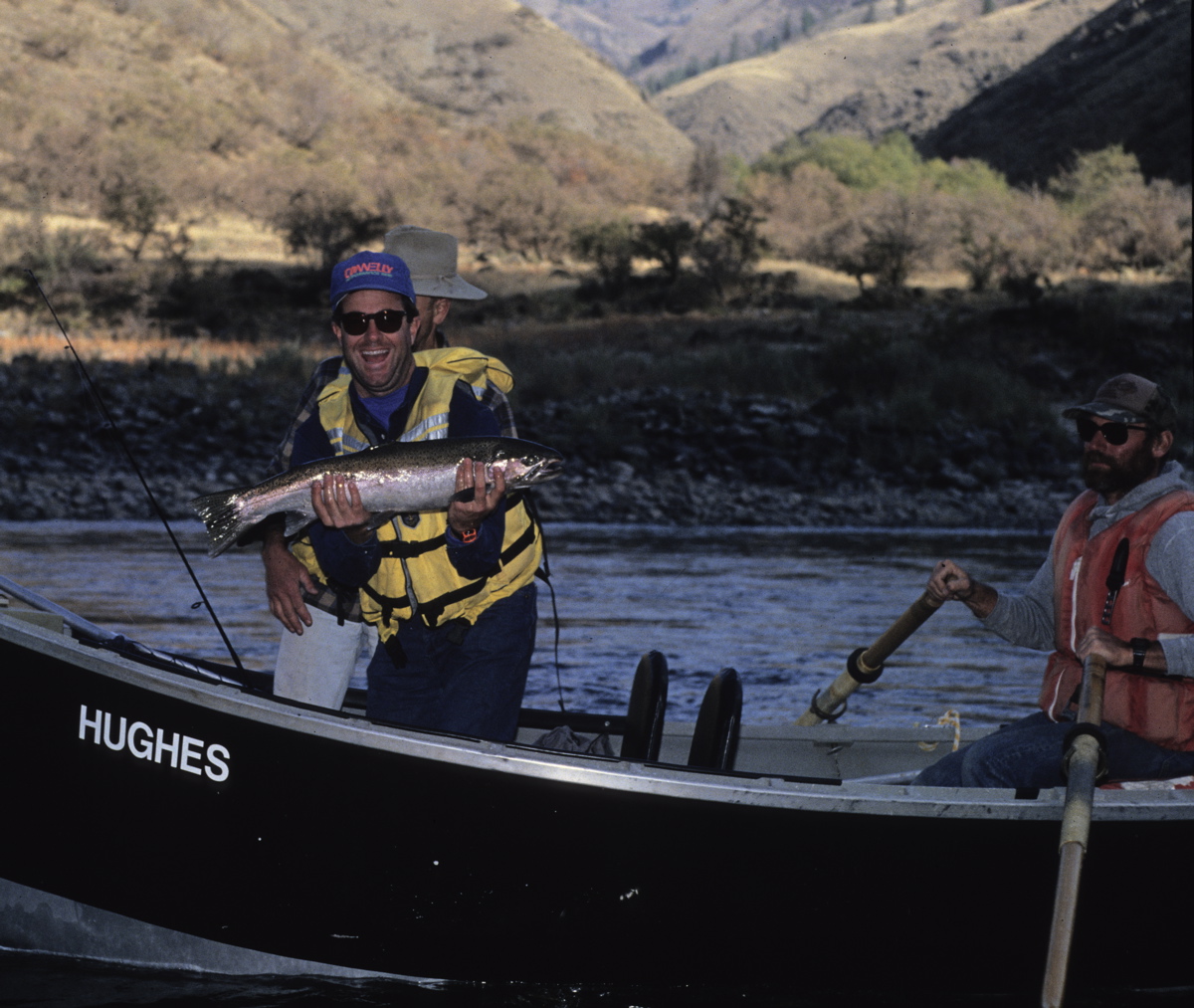Idaho: Drathaars, Steelhead and Chukars
“Star would also freeze on cats, chipmunks, porcupines and a string of brook trout my boys caught in a nearby beaver bond.”
Andrew, Robert, Star, Magpie
“Star may have been funny looking, but she was also tack smart and sweet tempered.”
Ted and Yatzi
“Mick Brethower of Georgetown, Texas nodded to Star and politely inquired. ‘What the heck is that?’”
Hughes, star and Steelhead
“Can’t say I’ve ever seen a dog point a fish before”
Lower Salmon
ed, Hughes, Yatzi, Whitewater
WHITE WATER
“Instead she traveled effortlessly, clearing scrub with graceful leaps, floating across shale slides and tracking uphill toward the towering rim rock.”
Matt Brethower, son, Chukar
For prices, details and launch dates for guided fall fishing/hunting trips on Idaho’s Salmon River, contact:
Jerry Hughes
Hughes River Expeditions Inc.
www.hughesriver.com
P.O. Box 217
Cambridge, Idaho 83610
800.262.1882
If I had doubts about taking “Star” my ten month old Drathaar on a four day, Lower Salmon River, cast and blast, in her defense, she had a ton of desire but not much discrimination. A big worry was, lacking live birds, I’d taught her to point a road killed magpie dangled from a fishing rod and now, watching her lock up on that fly blown black and white carcass, my hunting partner Chip Stanek observed, “I’d say you’ve got the best magpie dog in all of Idaho.”
“Magpies aren’t all she’ll point.” I quietly corrected him. Star would also freeze on cats, chipmunks, porcupines and a string of brook trout my boys caught in a nearby beaver bond.
It was Stanek who originally sang the praises of Drathaars. Chip’s “Ruby” was by far the best hunting black labrador I’d seen and when he returned from a week long chukar hunt the previous fall, I asked how she’d done. “Ruby did OK,” he confessed before adding, “but a six month old Drathaar hunted circles around her.” After listening to more such wild praise, I made a few phone calls and heard basically the same report from ex-Labrador owners who were now letting Drathaars sleep on the marital bed.
Though I detected a born again fundamentalism in these stories, the phone calls eventually led me to Jeff Funke of Three Devils Kennels in Boise. Jeff and his wife Heidi had just bred their “Diamond Muzz Chelsea” a 201 Point, Prize 1 NVHDA (National Versatile Hunting Dog Association) utility bitch to FC/AFC Bo Taylor Von Rahnhaus. One of the five females was “Star,” who howled inconsolably during the late night ride home when a brilliant meteor lit up the black Idaho sky.
The name “Star” sounded suitably southern and I quickly researched how those good old boys socialized their pointers. I’d always prided myself on being a tennis shoe trainer, but either I’d gotten a lot slower since my field trialing days or Star had a touch of Greyhound in her. At ten weeks she was ambivalent about the command, “COME!!!!” It wasn’t personal, she was just too busy investigating this mouse nest or that grasshopper. When hauling her in on a long line didn’t work, I figured a good spanking would clear the air.
Star only let me spank her once. After that she went back to chasing black birds and swallows around the back yard, keeping a wary eye and a constant twenty feet between us. Fearing I’d never get a handle on this zephyr, I resorted to boiled liver treats which stained my levis and made my hands smell funny, but which eventually did the trick.
Hughes, Star, Steelhead
Watching her race to nuzzle my pockets, my old field trial buddies were skeptical. “It’s hard to find an ugly puppy,” one noted, studying her youthful wire coat and scraggly whiskers. “….but I think you’ve succeeded.”
Developed in Germany during the nineteenth century, Drathaars were a mix of pointing Griffons, Pudelpointers, German Shorthair Pointers and Stichelhaars and were bred as versatile hunting dogs to hunt a range of game from rabbits to birds to deer. As a result, Star may have been funny looking, but she was also tack smart and sweet tempered. She did, however, exhibit a strong affection for Magpies.
Between the Magpies and liver treats, I was keeping my ten month old Drathaar on a short lead when I arrived in Whitebird, Idaho. That October, Columbia River dam counts revealed large numbers of Steelhead had eluded the downstream nets. Chukar populations were also way up for the four day, three night combination Steelhead fishing/Chukar hunting float trip with Hughes River Expeditions.
Following introductions at the launch site, Mick Brethower of Georgetown, Texas nodded to Star and politely inquired. “What the heck is that?” Mick had brought his black lab “Mocha,” and naturally figured Star was a mongrel–a mix of Lady and the Tramp I’d rescued from the pound.
In an attempt to defend her I replied, “She’s a Drathaar.” Then, trying to add a little drama, I added, “She’s also called German Wirehaired Pointer!”
guide Jim Otto, Mick Brethower
“Can’t say I’ve heard of one,” Mick said studying her with a critical eye. “Does it actually point?”
Coming from Texas, I knew Brethower measured Star against English Pointers–those bird finding machines that, when they die, have statues erected over them. Without mentioning the Magpies, I replied, “These Drathaars not only point like crazy, they’ll break ice to retrieve ducks!”
“Really?” Mick didn’t quite hide the doubt in his voice.
Another hunter brought his Cocker Spaniel “Yatzi” which bore a strong resemblance to my neighbor’s lap dog “Yippy.” Ted had an arthritic hip and Yatzi was criminally short legged, which seemed a bad combination for chukar country. To make matters worse, Star wandered too close while Yatzi was eating part of a leftover donut and when the dust settled, my Drathaar had a bloody puncture in her nose.
“I guess I should have told you that Yatzi is pretty protective of her food.” Ted apologized.
It was early afternoon when our group of six clients and five guides climbed into the Mackenzie boats below White Bird. Rowing into the current, outfitter Jerry Hughes suggested we get our lines in the water. Tying on Wee Worts and Hot Shots, we set the rods in the holders and settled back to enjoy the Lower Salmon’s spectacular scenery. We were still within sight of the launch ramp when Mick’s rod suddenly arced toward the dark water. Exploding out of the deep pool, a huge steelhead tail walked toward our boat.
I was watching the action and stopped paying attention to Star. Surprised by the fish’s noisy fight, she braced on the bow, leaned far out over the water and locked.
STAR Pointing STEELHEAD
“Can’t say I’ve ever seen a dog point a fish before,” guide Bob Sales commented.
We hooked a dozen steelhead that afternoon and were late reaching camp. Two swampers had floated ahead to the sand bar and set up the tents, kitchen and bar. The charcoal for the dutch oven dinner was being lit when I grabbed my 20 gauge autoloader, whistled up Star and started to climb.
The Lower Salmon River runs through ancient Columbia lava flows where towering black cliffs alternate with yellow cheat grass, green madrone and mature douglas fir. In places the hillsides are precipitously steep and I was trying to keep my balance when six chukar roared over me. With one hand on the twenty gauge and one on a clump of madrone, I could only watch the birds diagonal across the hillside then flare over an intervening ridge into the rim rock. I expected to see Star in hot pursuit, but when she didn’t appear, I humped up the face and found her on the flats above, looking every bit like a big league shortstop bracing for a bad hop. Hunkered down, she was vacuuming scent, feinting and back tracking–at ten months doing a fine imitation of a pointer. Except the birds were now a mile away.
Idaho’s six year drought had created record chukar populations and as late two weeks earlier, thousands of these exotically colored partridges were chuckling from rocks, sunning themselves on the Lower Salmon’s sandy beaches and flying in tight formations from bank to bank. But record fall rains had scattered the covey and we returned empty handed in the dark. Not that we were totally skunked for Star had pointed three chipmunks and gave serious consideration to four mule deer she jumped off a spring. She studied a red tail hawk and threw a point on a flock of magpies which, if I had a camera, could easily have made the Remington calender. In hindsight, we were lucky we didn’t see a skunk.
Empty handed, however, was empty handed. To make matters worse, Yatzi, the short legged cocker had led Ted to a covey. Over dinner, Ted treated us to a detailed description of Yatzi’s fine stalk, Yatzi’s brilliant retrieve and how the two unruffled chukar would make fine mounts. “By the way, ” he said, pulling Yatzi onto his lap. “How did your wire head do?”
“Wire Hair,” I corrected him.
By the following day, Star had gained valuable river experience. True she went swimming twice while pointing steelhead, but the dunkings didn’t seem to discourage her. I’d lift her back in and she’d lock back up. The guides got to calling her “Steelhead” which was better than “Wire Head,” but I didn’t like it much when they said she was a natural born “Clown Dog”.
“Funniest thing I’ve seen,” Sales admitted as the boat ground into the gravel beach below camp. Star jumped out and immediately found a chukar wing.
“Some guys and their dogs were leaving when we pulled in,” one of the swampers apologized. “They’d been here three days and said the hunting was fantastic.”
Despite having to follow the earlier party, we couldn’t have asked for better habitat. Lush cheat grass covered the rolling hills and there were clear springs surrounded by choke cherries. Grasshoppers flew in clouds around our feet but the birds were scattered and we eventually split up. Mick went upriver, Ted headed down river and I climbed.
Pulling Plugs, Salmon River
Up to that point, Star hadn’t produced a ton of chukar or, for that matter, even one chukar but unlike my labs, she refused to succumb to the heat and drag along at heel. Instead she traveled effortlessly, clearing scrub with graceful leaps, floating across shale slides and tracking uphill toward the towering rim rock. She quickly learned to avoid the ground hugging cactus that covered the arid south slopes. Pounding over the same territory, my old lab would invariably fill his legs, chest and muzzle with spines. Star collected two in four days.
We were high at the edge of the rim rock when two shots echoed up river. When we dragged into camp two hours later, Ted related how Yatzi had flushed two Hungarian Partridge. The short ranging cocker had given him ample time to drop the escaping birds. Yatzi made a brilliant retrieve and Ted planned to add the unruffled Huns to his Chukars in a high country mount.
Collapsing into a chair, I watched Star nose her dinner then curl up in the warm sand and fall asleep.
The following morning we woke to pecan pancakes, bacon, fresh fruit and cowboy coffee, then returned to pulling plugs on the Salmon. Steelheading was red hot and Star took her place on the bow testing the air currents that eddied off the north shore. That morning we ran class three white water at Bodacious Bounce rapids, caught six steelhead and swam at lunch. Uncasing my twenty gauge in the heat of the day, I called Star and traversed past ghostly Chinese mining claims. Climbing the steep hot slope, Brethower, Otto and I edged into a stand of an old manzanita where, lifting her nose into a hot breeze, Star turned and locked.
Every pointer owner wishes he’d taken more photographs. I do. This time Star wasn’t pointing a chipmunk, or a magpie, or mule deer but a covey of chukar wearing track shoes. She was too young to know the birds were running. Shots sounded on my right at the same instant a dozen feathered rockets banked through the trees. Leading one by three lengths, I touched off a Hail Mary shot that tumbled a single bird. I worked Star downwind of the hot cripple and there, in front of Jim and Mick, she locked in a beautiful, tail high, back straight, head outstretched point.
That lone chukar shifted my young Drathaar into high gear. She forgot about the chipmunks, magpies, deer and hawks. She’d still point a steelhead but chukar were her true passion and over the next days, she pointed half a dozen more. That’s not to say she was steady to wing and shot, or that I shot all six, but I shot enough and by the time we reached the confluence of the Snake, the guides had dropped the business about “Clowndog.”
Even Ted said she was “darn nice,” praise, in all honesty, I had no trouble returning about Yatzi.
But the highest compliment came from guide Jim Otto. Patting Star, Otto admitted, “I might even think of one of these Wire Hair things for my next dog.”



